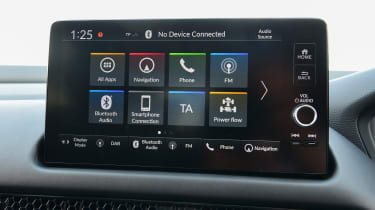Honda ZR-V review - Interior, design and technology
The ZR-V’s styling is unlikely to win hearts and minds, but its simple, logical cabin might sway some buyers

Honda has adopted a more restrained design language in recent years, which was a welcome change after the needlessly complex styling of the previous Civic and CR-V. The Japanese firm also worked hard not to make the ZR-V simply look like a jacked-up version of the 11th-gen Civic, and it has certainly succeeded. However this is not a car we expect will be bought on looks alone. The beak-like nose in particular, with its huge-slatted grille, isn’t nearly as subtle as other Hondas. The Kia Sportage and Hyundai Tucson are more handsome and striking, while the Nissan Qashqai has a rather understated look.
Inside, however, the ZR-V’s cabin looks almost identical to the Civic’s. But that’s not a bad thing, because it’s sensibly thought out. There are lots of soft-touch materials too, and the artificial leather on the dash has a metal-flake finish that creates a subtle sparkle in the light. Build overall is excellent and we’re pleased to see Honda sticking with conventional rotary controls for the heating and ventilation.
The floating centre console is a small flamboyant touch. It houses the array of buttons for selecting gears and drive modes, and a pair of USB ports for charging mobile devices, plus a wireless charging pad on higher-spec models. Every ZR-V features a nine-inch touchscreen, while behind the steering wheel, you’ll find a 10.2-inch fully digital driver’s display.
Equipment levels are generous across the ZR-V’s three trim levels – Elegance, Sport and Advance. As well as the two displays previously mentioned, base Elegance-spec models also come with 18-inch alloy wheels, front and rear parking sensors, a leather steering wheel, heated front seats, a rear-view camera, Android Auto and wireless Apple CarPlay, plus a range of safety and driver-assistance features as part of Honda’s ‘Sensing’ set-up.
Moving up to Sport trim adds some exterior tweaks in the form of a unique front bumper and grille, gloss black mirrors and window trim and matte black wheels. Inside, you’ll find a mix of fabric and synthetic leather trim for the seats, sports pedals, ambient LED lighting, an electric boot lid, wireless smartphone charging and extra USB-C charging ports for rear passengers.
The range-topping Advance builds on that by offering perforated leather seats, a heated steering wheel, panoramic sunroof, diamond-cut alloys, a new Bose sound system and a six-inch head-up display.
Sat-nav, stereo and infotainment
Compared to the latest family cars and SUVs, the ZR-V’s nine-inch screen is fairly small. However, it’s more than large enough to cover most buyers’ needs. It’s a very simple, intuitive system to use, with the main home page consisting of two rows of shortcut tiles for the main functions. Physical buttons to the side include a back key and a home key, plus a volume dial.
On-screen shortcuts make the Honda’s interface easy to figure out, even if you’re buried in a sub-menu about hybrid powertrain stats. The on-screen mapping is also clear. While the interface itself is easy to figure out, it’s not the quickest system when it comes to loading times or how long it takes to respond to on-screen touches. The wireless Apple CarPlay works fine, but we struggled to establish a connection with Android Auto when we tested the ZR-V; it either dropped instantly or failed to completely connect using various USB cables.










